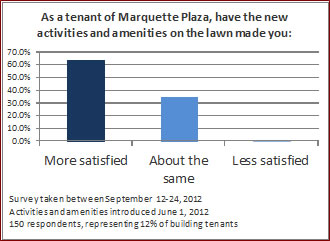Knight Foundation Soul of the Community Research found attachment to place drives a community's economic vitality. As part of the Saint Paul Riverfront Corporation placemaking series highlighting the Knight research, Minnesota Compass co-sponsored an event to look at economic and social outcomes related to placemaking. At the event, Max Musicant, Founder and Principal Placemaker of The Musicant Group, demonstrated measurable impacts of placemaking through a case study examining his work in Cancer Survivor’s Park, located on Nicollet Mall. We followed up with with Max to learn more.
What is placemaking and what are its benefits?
In my view, placemaking is the art and science of creating places of attachment and meaning. A space can be anywhere, but a place is somewhere that holds emotional, symbolic, or social meaning for people. In the work I’ve done and seen these attachments are formed through experiences. At the Musicant Group we transform under-used spaces (parks, plazas, streets, sidewalks, common areas, etc.) into active destination places that people seek-out and form attachment to. We believe that if you create a place where people want to be on a daily basis, that they will then want to live, work, shop, eat and play nearby. This is good for surrounding property owners, retail businesses, and neighbors. In addition to these economic benefits, places where people want be also facilitate an increased sense of community, the formation of social capital, and a reduction in crime.
What did you do for the Cancer Survivor's Park placemaking project?
The owners of Marquette Plaza and Cancer Survivor’s Park wanted to convert the privately owned public park into an active place and more valuable amenity for their 1,200 tenants and the surrounding downtown community.
Our group was brought in. Using the placemaking strategies pioneered during the redevelopment of New York City’s Bryant Park, we introduced a number of cost-effective amenities, programs, and events to increase the lawn’s usage on a daily basis. Over the course of the summer, the largest green space on Nicollet Mall was transformed by the addition of interactive games, amenities, furniture, and free programs were produced via partnerships with local businesses and nonprofits.
That all sounds great, but how did you measure your impact and success in Cancer Survivor’s Park?
There were a couple of ways. First and foremost we had to measure whether there actually were more people using the space – because if they weren’t, then we couldn’t claim that we had created “a place where people wanted to be." So over the course of the summer we did periodic stock counts of usage during the lunch hour and compared it to similar data we had collected before our work began. Using this measure found that our work increased usage in the park by between 300-500 percent on typical days.
But, increased activity alone was not enough to demonstrate the value that we were creating – we wanted to dig deeper and really show that the increased activity was having a positive impact on our client’s bottom line. After our work in the park closed for the summer, we sent a survey to all 1,200 tenants in the building, including asking if the park activities made them more satisfied, about the same, or less satisfied as a tenant.
When this data came back, we had our “aha” moment when we really knew we were on to something. Not only had we increased activity, but now we had solid data showing that our client’s investment in placemaking had increased tenant satisfaction for 64 percent of respondents and only irritated 1 percent.

We had created a place where people wanted to be and shown that they now wanted to work nearby even more. Further, we got lots of comments back from tenants like: "Although I was only able to participate a small amount (sic), all of the activities generated a great vibe for the Plaza. I actually believe it made the tenants feel more connected and part of a community. Please repeat this next summer.”
How can we promote change for the better?
I am a big believer in that you get 10 percent of what you want through obligation, or “you should do this,” but you only get the other 90 percent by demonstrating that something is really an opportunity, i.e., “you stand to benefit from this.” This is the strategy we take to make change and how we are dramatically improving the quality of our public realm. We show that not only is investing in a better, more active public realm the right thing to do, it is also the smart thing to do – whether you are a business, municipality, property owner, community group, health provider, or NGO.
Insight opinions are the authors' alone and do not necessarily reflect the views of Minnesota Compass. Compass welcomes a range of views about issues pertaining to quality of life in Minnesota.